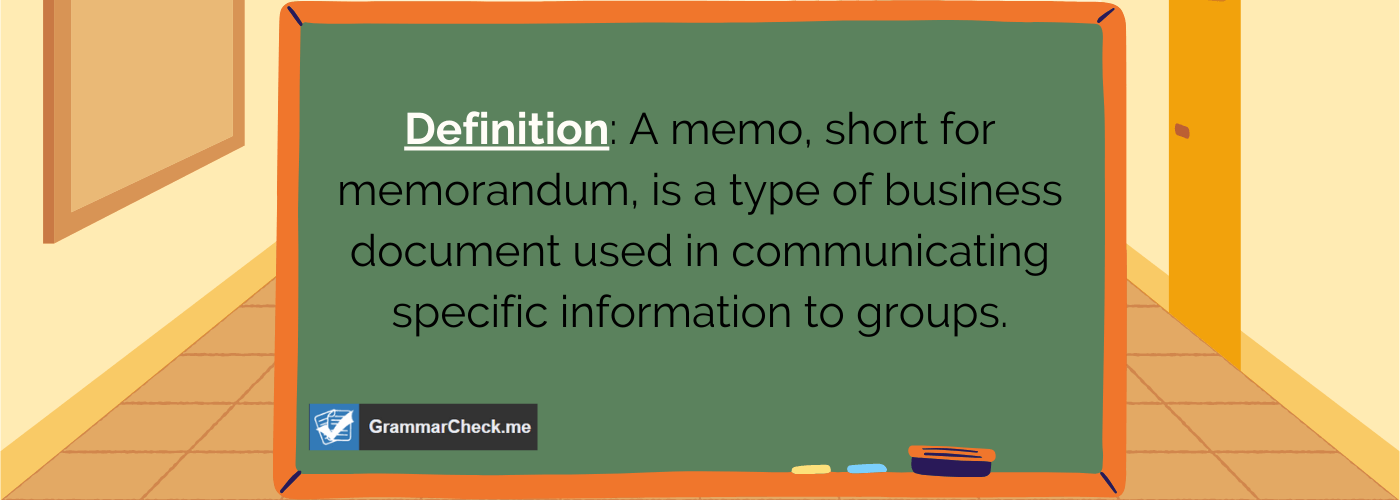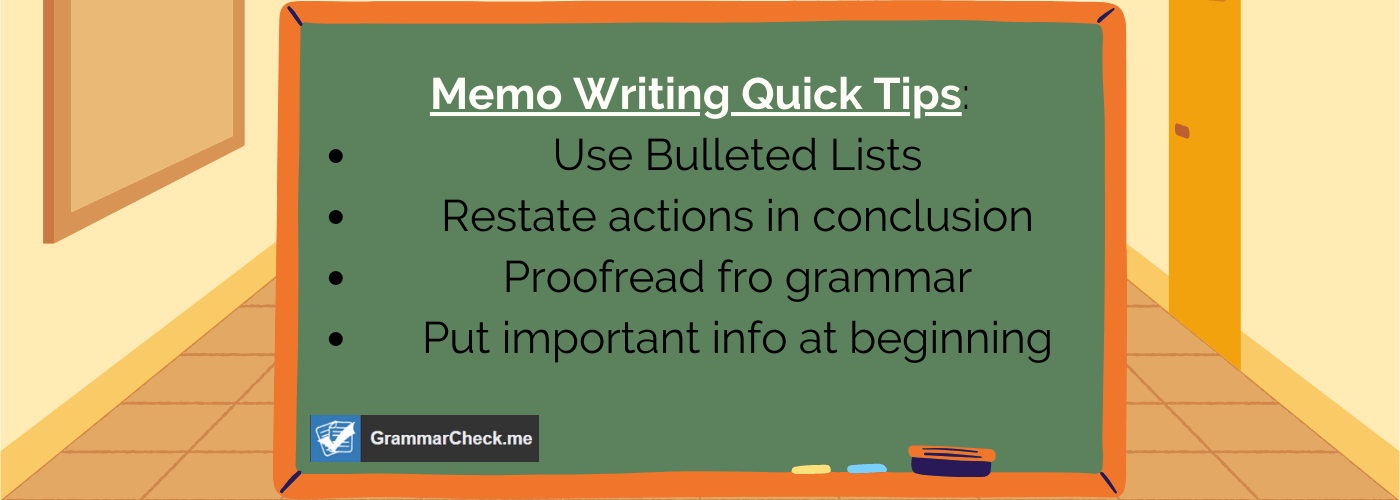Memos are an important part of the business world, but all too often they are ineffective and ignored. In order to write an effective memo, you need to be clear, concise, and accurate. Many people do not understand how to write an effective memo. Lucky for you, this article will teach you how to write memos that get results.
The Basics

Definition: A memo, short for memorandum, is a type of business document used in communicating specific information to groups.
The title implies that whatever is contained in the memo should be remembered in the course of business, though the purpose is somewhat broader in practical application.
In the business world, a memo can be used to quickly and effectively communicate any vital information in a formal way. They are often used to communicate within a company to explain procedures, changes, and other facts that are necessary to the business.
Writing a Memo
Memos are typically used to pass information to large groups, but groups have varying needs.
- The most important factor to consider when writing a memo is who will be reading it.
You need to clearly define the audience in order to include the right information in the message. A memo to executives aware of upcoming changes will probably include less information than a memo to other workers who are approaching the topic with limited knowledge. It is also important to not forget basic grammar & capitalization rules!
Key: Decide who needs to know, the recipient’s name and job title, what is going in the memo, what they know about the topic, and the best way to tell them.
After you know this information, you should start writing your memo by following the appropriate format. Some companies and industries have specific memo templates that must be used, while others allow memo writers to adjust the format as necessary.
Write A Memo Introduction
To start, you should know that memos follow all the standard writing conventions. Most memos start with a header that looks something like this:
To: The Accounts Payable Team
From: Susan Walker, Team Leader
Date: 17 April 2014
Subject: Upcoming Strategy Meeting
The reason most memos start with a powerful sentence starter in the heading similar to this example is that it quickly informs readers of the most important information in the message, namely, who it applies to, who sent it, when the memo was sent, and what the memo is about.
This allows readers to quickly understand the impact of the memo. Remember, memo’s follow a very specific format that allows information to be clearly and concisely communicated to the audience!
Write The Memo Body
After you have written the address & a strong title, it is time to work on the body of the memo. The body of the memo will contain your actual message.
- Because memos are used in business and most recipients are busy, the goal should be to quickly pass information without taking much time to read it.
Start the message quickly and get to the point. Often they start with the event that caused the need for a memo: “It has come to my attention” or “In lieu of previous discussions,” can be common introductory phrases. These phrases establish the background of the issue.
Typically, this is followed by the key point of the memo.
- For example, “It has come to my attention that there are conflicting messages about the new reporting system. In order to resolve the confusion, we are having a strategy meeting on 18 April…”
For longer memos, you may choose to make the introduction a summary of all the points contained in the rest of the memo in order to facilitate quick reading. Remember, just because you are writing a memo doesn’t mean you can ignore the standard rules of syntax & grammar!
After the background and point are stated, you can include any other needed information. This may be details about a new process, action steps for employees, instructions, or further reasoning for actions.
Tip: The best memos are ones that cover all questions, including the reasoning behind any decisions.
In order for a memo to be effective, it must accomplish the task of making the recipient remember something. Typically items are more memorable if the recipient understands the connection to other items. Try to find an approach to the topic that will answer all questions.
Write A Memo Conclusion
Many memos also contain a section at the bottom for action steps to be completed in order to make it easier for readers to understand the expected action. By including summaries like these, your memo will be far more effective at accomplishing its results. Readers can simply print the memo and use it as a checklist when needed.
- Close with a friendly comment and your signature. You may choose to include further resources, such as a contact or reference to data for further questions.
Your goal in writing a memo should be to get the message across and make it as easy to understand and memorable as possible. You should consider using any tools that may aid understanding, such as supporting documents or reports that can be attached.
Memo Writing Quick Tips

These bullet points are a comprehensive list of the best tips for writing an effective memo.
- Bulleted lists can greatly aid understanding, particularly when outlining a multistep approach to a process.
- If you include an attachment, you may choose to add an attachment note in the header. For example, “Attached: Quarter 3 Results 2014.” This tells readers that there is an attachment to reference.
- Closing by briefly restating any actions readers may need to take can help achieve better results.
- Don’t forget to edit your memo for understanding and grammar.
- Follow the standard prescriptive & descriptive grammar rules as you would in any other body of formal writing.
- If the information you are sending is sensitive or complicated, you may consider having a meeting or talking to recipients in person. While memos are effective for quick communication, they are not always effective in complex situations.
- Try to keep memos as short as possible, since they will be read quickly.
- Put any important information near the beginning of the memo or in any lists or summary sections to ensure this information is read.
- Be polite and professional in memos.
- Use terms that are easy to understand. Memos should be easily readable, so only include technical terms if you are sure all recipients will understand.
- If you have a group with many different levels of experience with the topic, provide summaries of the information for those who understand the topic and provide extra information in the body of the memo for those who need more information.
FAQs – Writing Memos
A writer’s memo is usually a page or two long, but can be shorter or longer depending on the project. For example, a memo for a pitch may only be a paragraph or two, while business memos may be several pages.
There are four basic types of memos: request, confirmation, periodic report, and ideas and suggestions. These four types of memos serve different purposes, but all should be clear & concise.
To begin a memo, start by quickly and clearly stating the purpose of your memo. Include WHO the memo is for, WHAT you are recommending or decision you are making, WHY this is important, and WHEN this will happen.
Not exactly. Memos are more straightforward and to the point than essays. They is often less formal as well, although that can depend on your company culture and the norms around memos in your industry.
A policy memo is a type of formal memo that typically contains a summary of findings or recommendations, and is usually written for an audience of decision-makers. The purpose of a policy memo is to provide clear and concise information that will help the reader make informed decisions.
There are several elements that should be included in a policy memo. First, there should be a problem statement explaining the issue at hand and why it is important. Second, there should be an analysis of the root causes of the problem. Finally, there should be a statement on the significance of the problem.
Here are the 7 steps to writing an effective business memo:
1. Format: Memos are typically one to two pages long, single-spaced, with a font size of 10-12 points.
2. Label: Memos should be labeled with a subject line, To:, and From: lines, the date, and a memo number (if applicable).
3. Headings: Headings can help organize your thoughts and make the memo easier to read.
4. Introduction: The opening paragraph should include a brief explanation of the issue or problem at hand.
5. Memo Body: The body of the memo should provide more detail about the issue or problem and present possible solutions.
6. Conclusion: Just like the first paragraph, the conclusion should summarize the key points succinctly.
7. Proofread: Make sure there are no spelling or grammatical errors & that the writing is appropriate for your target audience.
Yes, memos usually have paragraphs. This helps to organize the information and make it easier to read. Each paragraph should focus on one main point, and you can use headings to identify each main point. This will help the reader know what to expect from each paragraph.
Most memos do not exceed three or four paragraphs, as they are meant to be succinct and to the point. Memos are more of an executive summary. Longer memos may be more appropriate depending on the specific audience.
The Bottom Line
Memos are an essential part of the workplace, but they can also be a headache to write. By following these tips, you’ll be able to structure your memos more effectively and make them easier for your readers to understand. If you want to double-check your writing, throw your memo into our FREE Essay Checker and get instant feedback. Give these tips a try on your next memo- we promise it will make the process smoother for everyone involved.
